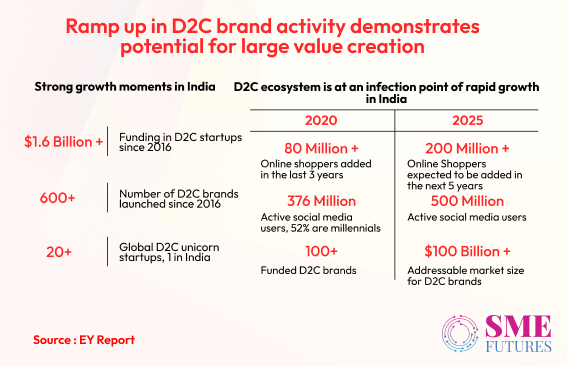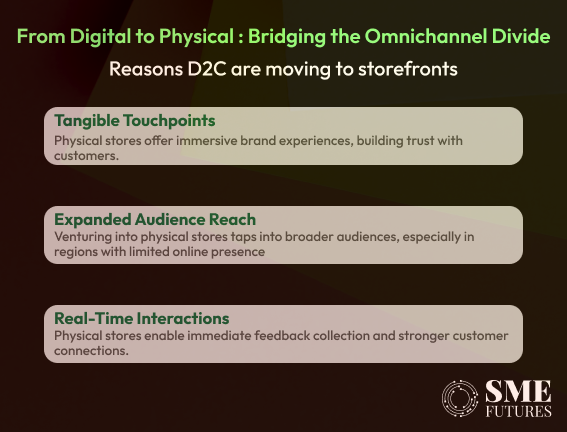At one juncture, the term D2C emerged as a cutting-edge business strategy for brands seeking growth and success. These brands swiftly swept through India Inc., some even ascending to unicorn status. But if you were asked what D2C brands would do once their online marketplaces reached saturation, what would your response be?
The logical answer seems to be a return to basics, right? This is precisely the path that many D2C businesses are currently taking. Brands like Boat, Bombay Shaving Company, Mamaearth, Smytten, Wakefit, and Blissclub, among others, share a common origin—they were once pure D2C entities. Born and nurtured in the online realm, these brands are now reshaping the D2C landscape by shifting from virtual spaces to physical storefronts.
This transition signifies a significant moment in the Indian commerce scene, as digital-native brands venture out from behind screens to establish tangible footprints. However, is this migration a regression of sorts, or an evolution towards a seamless fusion of online and offline experiences? It’s food for thought.
“I believe that moving direct-to-consumer (D2C) brands into offline retail spaces is a natural and much-expected evolution in their growth strategy,” says Umair Mohammed, Co-Founder and CEO at Nitro Commerce, that helps brands to go online with tech solutions.
“Like traditional retail brands that have embraced the D2C approach, these brands are expanding into traditional channels to broaden their consumer reach and set the ball rolling for their brand presence,” he adds.
“However, opening a physical store is akin to the art of storytelling, which presents its own set of challenges,” remarks Preeti Chopra, VP of Business Development at Being Human, during a panel discussion on the evolving role of physical locations in an era dominated by digital platforms.
“Unlike online platforms where product features may speak for themselves, the true essence of storytelling comes alive in a physical store. By storytelling, I mean the meticulous attention to detail in store layout, visual merchandising, and customer interaction,” she adds.
Undoubtedly, maintaining a physical presence is much more work than operating an online shop. But there are reasons behind why D2Cs are now jumping on the going physical bandwagon.
Why physical is motivating
Let’s begin with the basics!
In India, a strong belief in the significance of tactile experiences, personal connections, and face-to-face conversations still prevails. Consumers always resonate more with those brands that make shopping a therapeutic and tactile experience for them. It appears that this very sentiment is propelling D2C brands to venture one step further and embark upon the opening of physical stores.
However, there are other compelling reasons as well.
Ishit Jethwa, Founder of the emerging lifestyle brand Ludic sums it up, saying, “By leveraging offline retail spaces along with digital channels, D2C brands can now quite easily achieve two-fold returns, such as creating brand awareness and visibility and increasing customer engagement, leading to additional revenue in a dynamic retail landscape.”
Moreover, having an offline presence offers several advantages such as market expansion, brand enhancement, omnichannel integration, product exposure, and competitive advantage.
Mohammed elaborates, “Venturing into physical stores allows D2C brands to provide customers with tangible product experiences and immediate gratification, which are challenging to achieve online.”
Another significant factor is the surge in transaction value compared to online sales. Let’s consider the case of Nykaa, which effectively demonstrates both points.
Lifestyle e-commerce giant Nykaa, operational for over 12 years, has witnessed remarkable success through its offline store presence.
“Even as we transition into physical retail spaces, our customers expect the same level of experience and quality that they’ve come to associate with Nykaa online. The physical space provides us with the opportunity to showcase our commitment to customer service,” highlights Kunal Bansal, VP Operations & Business Development at Nykaa.
“We’ve noticed that customers visiting our stores tend to make purchases four to five times more compared to online shopping. This trend can be attributed to the immersive experience that our physical stores offer. Cosmetics, being an indulgent category, particularly appeal to women who relish the opportunity to spend time in-store, exploring various products. This encourages additional purchases through cross-selling and upselling. Consequently, we’ve witnessed a notable increase in transaction value compared to online sales,” he adds.
According to him, the physical environment plays a crucial role in driving higher sales rates and conversions, with Nykaa experiencing conversion rates exceeding 8%.
Mohammed concurs, adding, “I think this trend remarkably reshapes the retail landscape and shifts consumer behaviour towards valuing an integrated shopping experience. Consumers are increasingly driven by not just price but by value, which encompasses quality, authenticity, and the immediacy of access that offline experiences can provide.”
D2C brands’ expansion into physical retail is a sign of the maturation of their business models, increasing market maturity, and consumer acceptance of digital-native brands.

Tectonic shift in retail dynamics
But what impact does this migration have on the retail landscape in India? According to Gaurav Singh, Founder & MD, Atulya – Beacon Bio Life Sciences, it’s nothing short of revolutionary. The fusion of digital-native brands with physical storefronts isn’t just a trend; it’s a seismic shift in consumer behaviour and market dynamics.
Traditional brick-and-mortar retailers are forced to adapt or risk obsolescence in the face of this new competition. The emergence of D2C brands in physical spaces signals not a reversal, but rather an evolution towards a hybrid retail ecosystem where online and offline channels coalesce to redefine the shopping experience.
Here competition will become the biggest factor, feel D2C brand owners.
Directly or indirectly, expanding D2C brands into offline channels spurs innovation and transformation within the traditional retail sector. It will impact the brick-and-mortar retailers’ significantly. “They need to adapt to changing consumer preferences and market dynamics to remain relevant and competitive,” Jethwa contends. “Otherwise, D2C brands bring their unique offerings and marketing strategies to physical storefronts, potentially capturing market share,” he adds.
To remain competitive, traditional retailers need to invest in omnichannel infrastructure, including robust inventory management systems and seamless online ordering platforms. To differentiate themselves from D2C brands, traditional retailers may need to emphasise their unique value propositions, such as personalised customer service, exclusive product offerings, or community engagement.
Conversely, Mohammed sees the expansion of D2C brands into offline channels as a positive development. “It will create healthy competition in the retail sector, which will drive innovation and lead to better offerings for consumers. Yes, it may challenge traditional retailers, but they can also capitalise on the opportunities,” he points out.

Trends influencing shopping habits
The convergence of Direct-to-Consumer (D2C) brands with physical retail spaces is poised to reshape consumer shopping habits and preferences both online and offline. According to the D2C stakeholders, this trend will usher in a new era of seamless shopping experiences, where consumers expect flexibility and personalisation across channels.
“As D2C brands leverage data to tailor recommendations and offers, consumers may develop stronger loyalty to those with a physical presence, perceiving them as more trustworthy. Additionally, integrating social commerce elements into offline spaces can blur the lines between online and offline shopping, influencing purchasing decisions,” Jethwa asserts.
When asked about their company’s plans in response to this trend, Jethwa reveals that Ludic is gearing up for offline expansion with Exclusive Brand Outlet (EBO) stores starting in 2025. Targeting metro and tier-1 cities aligns with Ludic’s focus on high-density areas with strong purchasing power, offering immersive brand experiences and engaging urban consumers seeking convenience and variety. This strategic move aims to capitalise on the trend of D2C brands expanding into offline spaces to deepen their brand presence and reach broader markets.
While Singh feels that the change will foster experiential retail environments, emphasising authenticity and transparency and facilitating exploration of niche products. However, in terms of opening Atulya’s store, he says that the company remains focused on digital platforms. Any decision to venture into offline channels would align with their long-term growth strategy and commitment to serving evolving customer needs.
For Mohammed of Nitro Commerce, it’s the motherload of opportunities, as they support both traditional retail and D2C models. The company provides merchants with the tools they need to succeed across all channels. This approach allows consumers to enjoy greater convenience and flexibility in their shopping experiences.
“Whether it’s through quick commerce options or the immersive experience of a physical store, we help brands adapt to consumer preferences, enhancing both online and offline shopping and fostering a more integrated retail environment. For us it doesn’t matter if a large e-commerce merchant enables its store as quick commerce or a D2C ventures into retail. What matters is that they have the right tools in their arsenal to achieve this objective. I believe it’s a win-win situation,” he says.











